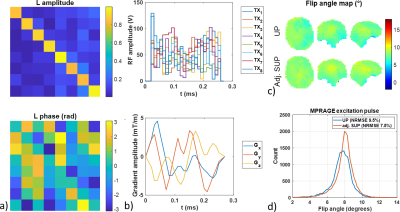Caroline Le Ster1, Franck Mauconduit1, Aurélien Massire2, Vincent Gras1, and Nicolas Boulant1
1Paris-Saclay University, CEA, CNRS, BAOBAB, NeuroSpin, Gif-sur-Yvette, France, 2Siemens Healthcare SAS, Saint-Denis, France
1Paris-Saclay University, CEA, CNRS, BAOBAB, NeuroSpin, Gif-sur-Yvette, France, 2Siemens Healthcare SAS, Saint-Denis, France
The pulse design process can be made transparent to the user with calibration-free universal pulses (UP). Here a new method is proposed where UPs are adjusted to scanned subjects through a fast calibration step. Adjusted SUP improve excitation performance and reduce intersubject variability.

Figure 1: Pulse design methodology in the volunteer for the MPRAGE excitation 8° GRAPE pulse. a) A calibration matrix (L) is computed to adjust the standardized universal pulse (SUP) designed over the standardized pulse design database to the subject B1+ map. Its magnitude is close to the identity matrix while diagonal phase terms are close to 0 radian. b) RF and gradient amplitudes of the resulting adjusted SUP. c and d) Flip angle maps and histograms retrospectively simulated on the subject for the UP and adjusted SUP with the subject’s full B1+ map. NRMSEs are 9.5% and 7.5%, respectively.

Figure 4: a) UNI contrast computed from the two inversion volumes of the MP2RAGE sequence acquired with the adjusted SUP. b to d) T1 map computed by injecting UNI signal intensities and sequence parameters in Bloch equation simulations for the MP2RAGE sequence acquired in the CP mode, CP mode with B1+ postprocessing correction and adjusted SUP, respectively. e) T1 distributions extracted from the brain for figures 4b to 4d, showing an improvement on the distributions.